
I took every photograph in each one of these books.
I processed the RAW image files using the develope module in Adobe Lightroom.
I also did Photshop editing as needed.





Copyright © 2021 by Renee Tucci
Library of Congress Control Number: 2020952558
All rights reserved. No part of this work may be reproduced or used in any form or by any means—graphic, electronic, or mechanical, including photocopying or information storage and retrieval systems—without written permission from the publisher.
The scanning, uploading, and distribution of this book or any part thereof via the Internet or any other means without the permission of the publisher is illegal and punishable by law. Please purchase only authorized editions and do not participate in or encourage the electronic piracy of copyrighted materials.
“Schiffer,” “Schiffer Publishing, Ltd.,” and the pen and inkwell logo are registered trademarks of Schiffer Publishing, Ltd.
The author in no way represents the companies, corporations, or brands mentioned in this book. These products have no brand affiliation with the production of this book.
Many items and products mentioned in this book are registered trademarks and all rights are reserved by their respective owners. These include Accent Décor; Design Master Spray Paint; Smithers Oasis
Cover and interior designed by Ashley Millhouse
Type set in Fertigo/Laca
Photography by Bob Smith
ISBN: 978-0-7643-6200-2
Printed in China
Published by Schiffer Publishing, Ltd.
4880 Lower Valley Road
Atglen, PA 19310
Phone: (610) 593-1777; Fax: (610) 593-2002
E-mail: Info@schifferbooks.com
Web: www.schifferbooks.com

Other Schiffer Books on Related Subjects:
Taking the Flower Show Home: Award Winning Designs from Concept to Completion, Bill Schaffer and Kristine Kratt, AIFD, PFCI, ISBN 978-0-7643-4430-5
Perishable Poetics: Manifesting Emotion through Contemporary Floral Design, Jenny Thomasson, ISBN 978-0-7643-5986-6
Floral Accessories: Creative Designs with Wendy Andrade, NDSF, AIFD, FBFA, Wendy Andrade, ISBN 978-0-7643-5446-5
For our complete selection of fine books on this and related subjects, please visit our website at www.schifferbooks.com. You may also write for a free catalog.
Schiffer Publishing’s titles are available at special discounts for bulk purchases for sales promotions or premiums. Special editions, including personalized covers, corporate imprints, and excerpts, can be created in large quantities for special needs. For more information, contact the publisher.
We are always looking for people to write books on new and related subjects. If you have an idea for a book, please contact us at proposals@ schifferbooks.com.


3. Roll the tip of the leaf until it meets back with the leaf body and staple it in place. Repeat to make several rolls, then arrange them in the trough.
4. Add flax leaves, at varied heights, and leave upright, for bending later in the process.
5. Place the protea throughout the trough to create a base.


1. Thread equisetum stems onto 2 pieces of 20-gauge wire to form a mat. For a 6” × 6” cylinder vase, the mat should be 16” long. The equisetum can be left at its natural length, to be trimmed and tailored later.
2. Curve the mat into a cylinder and place it in the vase.
3. Working with a presoaked brick of floral foam, set it next to the vase in the upright position for an easy measure of where to trim the equisetum. This will be the first, rough cut of the equisetum to make it easier to add the foam in. The final, tailored cut will be made in the following step. Trim the equisetum, leaving it extend about an inch above where the top of the foam will be. Then, cut a “U” shape out of the front portion of the equisetum to allow for more of the surface of the foam to be accessed. Shave the corners of the floral foam as seen in the Stacked Steps project (page 26), and place the upright brick of wet foam in the vase.
Tech Tips
✽ Using wire cutters, cut the ends of each piece of wire on an angle for easier piercing and threading of the equisetum.
✽ Try to choose equisetum stems that are as straight as possible.
✽ The sloped equisetum stems around the front benefit from not just a straight cut, but angling the cut downward, exposing a teardrop shape from their hollow stems.

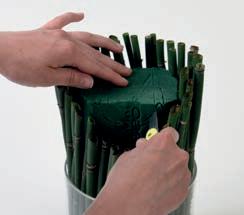


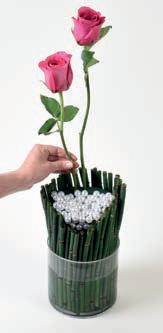
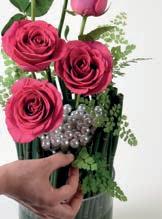



Finish trimming the equisetum so that it stands about 1½” above the foam in the back and slopes down to reveal about 2” of exposed foam at the front.
7. Place the roses into the back half of the foam. Arrange the roses using sequencing: place the tightest blooms highest, moving down to finally place the most widely open rose.
8. Add maidenhair fern around the base and through the cracks of the equisetum into the foam, tumbling down the column to introduce a fluffy texture in contrast to the very repetitious and smooth equisetum.
9. A grouping of bear grass is added to the back to bring the design into proportion and to balance the tumbling maidenhair fern.
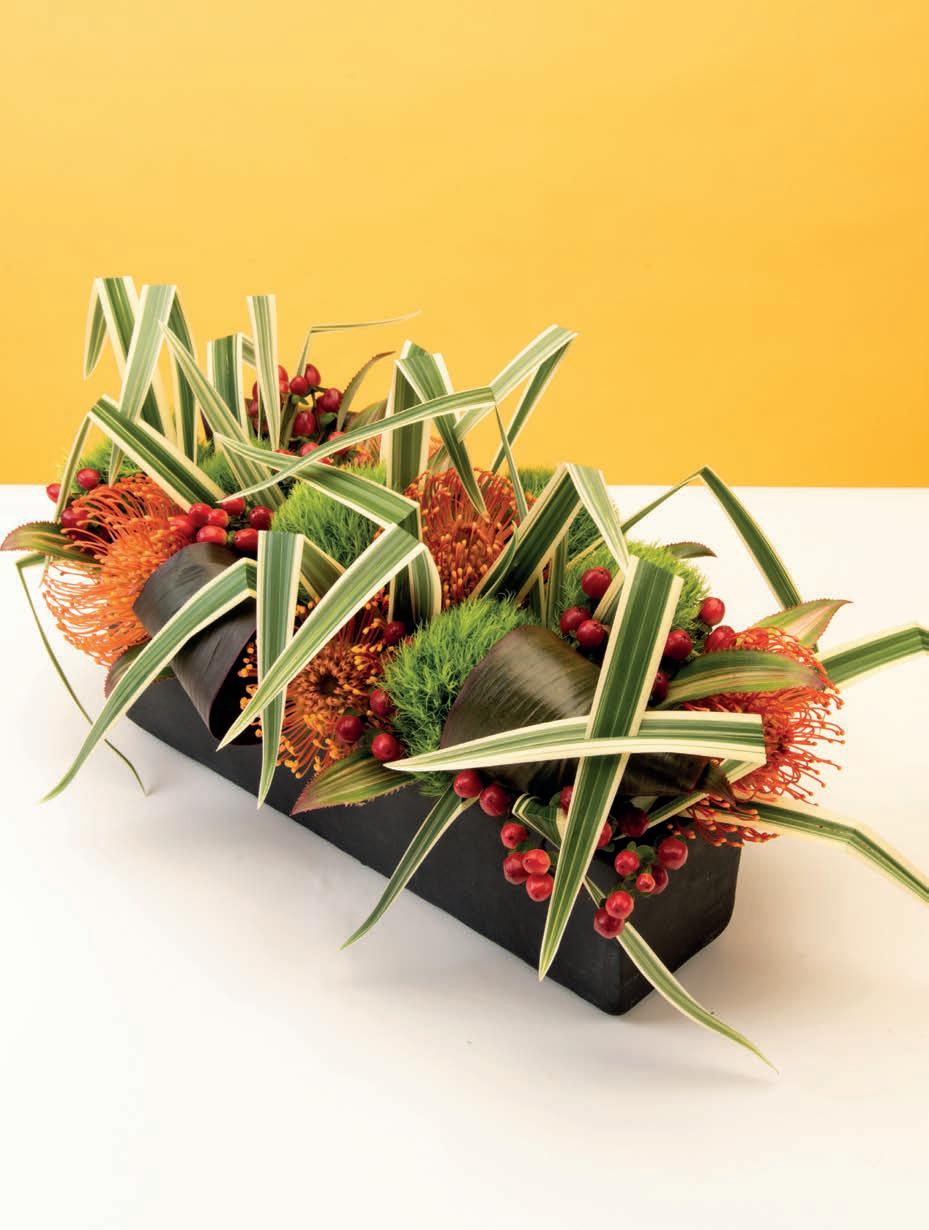



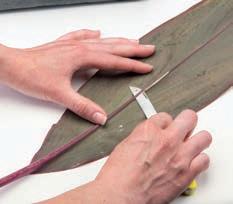

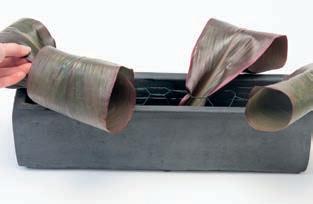
✽ If you have never partially cut a vein out of the back of a leaf, it is recommended to practice a few times until you get the feel of it. Also, when you are pulling the knife toward your body, please do so with care. Safety first!
✽ If you find that the full ti leaf is making too large of a roll, you can split the leaf in half, straight down the center, with the tip of your knife on the table. See how we did this with the monstera leaves in the Bundled & Braided project (page 114).
2. To roll the ti leaves, place the leaf upside down on the table. About halfway down the stem, where the vein begins to get thickest, slide a knife halfway into the vein. Pull the knife all the way down, removing the back half of the vein. The leaf will still be able to hold its structure and take up water, but it is now more flexible. Tech Tips


4.
5.
at

We would like to thank Robert and Frances Enck at Enck’s Gun Barn for encouraging us to write this book and providing the financial support to make it a reality. We would also like to thank our many shooting friends, too numerous to name, whose skill and wisdom helped craft this text. In particular, we would like to thank Andy McCauley for being an invaluable resource pertaining to shooting fundamentals. Special thanks to Keith Kreiser for his input on left-handed shooters. We would also like to thank Mark Booher of Barritus Defense for his knowledge about Israeli training and their mindset.
Thank you to Adam and Eric Wier for their encouragement and attention to detail when reading through various iterations of the book. Thank you to Aletheia Atzinger for reading early drafts of the book and helping to ensure it is as clear as possible.
Copyright © 2019 by Gregory M. Wier and Stephen D. Wier
Library of Congress Control Number: 2019936856
All rights reserved. No part of this work may be reproduced or used in any form or by any means—graphic, electronic, or mechanical, including photocopying or information storage and retrieval systems—without written permission from the publisher.
The scanning, uploading, and distribution of this book or any part thereof via the Internet or any other means without the permission of the publisher is illegal and punishable by law. Please purchase only authorized editions and do not participate in or encourage the electronic piracy of copyrighted materials.
“Schiffer Military” and the arrow logo are trademarks of Schiffer Publishing, Ltd.
Designed by Justin Watkinson
Photography by Bob Smith
Type set in Minion Pro/Univers LT Std
ISBN: 978-0-7643-5837-1
Printed in China
Published by Schiffer Publishing, Ltd. 4880 Lower Valley Road Atglen, PA 19310
Phone: (610) 593-1777; Fax: (610) 593-2002
E-mail: Info@schifferbooks.com Web: www.schifferbooks.com
For our complete selection of fine books on this and related subjects, please visit our website at www.schifferbooks.com. You may also write for a free catalog.
Schiffer Publishing’s titles are available at special discounts for bulk purchases for sales promotions or premiums. Special editions, including personalized covers, corporate imprints, and excerpts, can be created in large quantities for special needs. For more information, contact the publisher.
We are always looking for people to write books on new and related subjects. If you have an idea for a book, please contact us at proposals@schifferbooks.com.







FIGURE 4.8. After finding a handgun to conceal, you have to decide how best to conceal it. A. An outside-the-waistband holster stays completely outside your pants. The extra bulk can make the handgun hard to conceal unless you are wearing a jacket. B. An inside-the-waistband holster attaches to your belt and tucks inside the waistband of your pants. This makes the handgun easier to conceal but is usually less comfortable.

Fortunately, safely handling a firearm is not a difficult process (figure 1.1), and it can be broken down into three simple tenets:
1 A firearm should never be pointed at someone or cross over any part of a person.
2 Treat all firearms as if they are loaded.
3 Your finger should never be on the trigger until you are ready to shoot.
While these rules may seem self-explanatory, there are some nuances to each of them that warrant explanation. One of the strengths of this set of rules is that if you fail to meet some of them, so long as you follow even one, no one will get hurt in the event of an accident.
1.1. Rules of Safe Gun Handling
1. A firearm should never be pointed at someone or cross over any part of a person. You should not point a firearm at someone/something unless you are prepared to shoot them/it. This goes beyond intentionally pointing a firearm at someone. Since handguns are fairly small, it can be easy to unintentionally pass the front of the gun (the muzzle) over a part of yourself or someone else. With a rifle (sometimes called a long gun), it is a simple task to keep the barrel pointed away from yourself due to its length (figure 1.2). It is of paramount importance that you are always mindful of the facing of the muzzle when you are handling a firearm.
FIGURE 1.2. Since pistols are short and compact, it can be easy to inadvertently point one at someone. Rifles are considerably larger, making it harder to accidentally point one at someone.
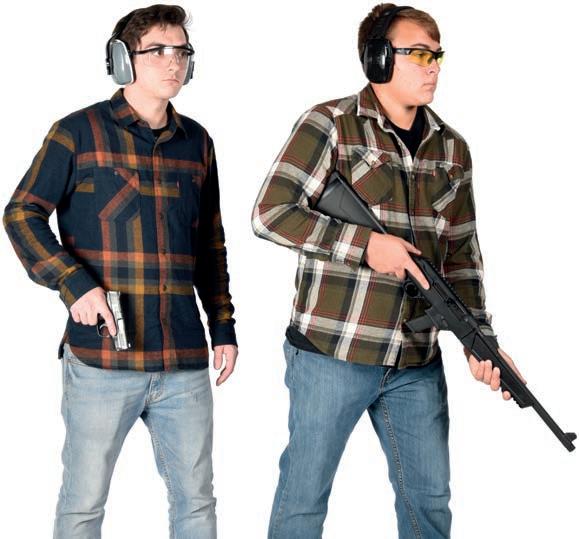
FIGURE 2.12. A clip is used to load cartridges into the magazine of a firearm. A. Pictured is a Steyr M1912 pistol. It has a springloaded magazine in the handle, but it is not removable. B. The slide of the Steyr M1912 has been pulled back, allowing the internal magazine to be loaded from above. C. A clip holding 9 × 23 mm cartridges is inserted into the pistol, situated above the integral magazine. D. By applying force to the cartridges, the cartridges are pushed into the internal magazine and off the clip. The clip can then be removed.





Copyright © 2021 by Trixi Symonds and Deborah Fisher
Library of Congress Control Number: 2020943411
All rights reserved. No part of this work may be reproduced or used in any form or by any means—graphic, electronic, or mechanical, including photocopying or information storage and retrieval systems—without written permission from the publisher.
The scanning, uploading, and distribution of this book or any part thereof via the Internet or any other means without the permission of the publisher is illegal and punishable by law. Please purchase only authorized editions and do not participate in or encourage the electronic piracy of copyrighted materials.
“Schiffer,” “Schiffer Publishing, Ltd.,” and the pen and inkwell logo are registered trademarks of Schiffer Publishing, Ltd.
Cover and interior design: Ashley Millouse
Photography: Bob Smith Type set in Goodlife/Azo Sans
ISBN: 978-0-7643-6127-2
Printed in China
Published by Schiffer Publishing, Ltd.
4880 Lower Valley Road
Atglen, PA 19310
Phone: (610) 593-1777; Fax: (610) 593-2002
E-mail: Info@schifferbooks.com Web: www.schifferbooks.com
For our complete selection of fine books on this and related subjects, please visit our website at www.schifferbooks.com. You may also write for a free catalog.
Schiffer Publishing’s titles are available at special discounts for bulk purchases for sales promotions or premiums. Special editions, including personalized covers, corporate imprints, and excerpts, can be created in large quantities for special needs. For more information, contact the publisher.
We are always looking for people to write books on new and related subjects. If you have an idea for a book, please contact us at proposals@schifferbooks.com.







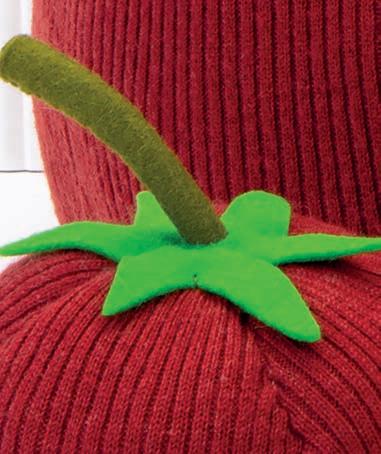
The projects in this book all need Basic Sewing Tools:
• Needles
• Thread or floss for basic construction of the softie
• Scissors
• Pins or clips



To Mary Mohr, a woman of lifelong strength, courage, and persistence who has always been a mover and a shaker not stopped by momentary setbacks. Not one to stand still, Mary is a woman of action whom I am humbled and proud to call Mom.
Other Schiffer Books by the Author:
Making Gourd Ornaments , 978-0-7643-2716-2, $12.95
Creating Snowflake Art: Designing Original Papercuttings , 978-0-7643-2971-5, $12.99
Apples to Apples: Basic Techniques for Decorating Gourds , 978-0-7643-3621-8, $19.99
Making More Gourd Ornaments , 978-0-7643-3620-1, $19.99
Gourd Art Basics: The Complete Guide to Cleaning, Preparation, and Repair , 978-0-7643-2829-9, $14.99
Gourd Puppets and Dolls: A Do-It-Yourself for Crafters , 978-0-7643-2868-8, $15.00
Historic Gourd Craft: How to Make Traditional Vessels , 978-0-7643-2830-5, $15.00
Making Gourd Headpieces: Decorating and Creating Headgear for Every Occasion , 978-0-7643-2869-5, $15.00
Copyright © 2019 by C. Angela Mohr
Library of Congress Control Number: 2019936344
All rights reserved. No part of this work may be reproduced or used in any form or by any means— graphic, electronic, or mechanical, including photocopying or information storage and retrieval systems— without written permission from the publisher.
The scanning, uploading, and distribution of this book or any part thereof via the Internet or any other means without the permission of the publisher is illegal and punishable by law. Please purchase only authorized editions and do not participate in or encourage the electronic piracy of copyrighted materials.
“Schiffer,” “Schiffer Publishing, Ltd.,” and the pen and inkwell logo are registered trademarks of Schiffer Publishing, Ltd.
Photography by Bob Smith
Designed by Ashley Millhouse
Cover design by Brenda McCallum
Type set in Univers/Helvetica Neue
ISBN: 978-0-7643-5832-6
Printed in China
Published by Schiffer Publishing, Ltd.
4880 Lower Valley Road
Atglen, PA 19310
Phone: (610) 593-1777; Fax: (610) 593-2002
E-mail: Info@schifferbooks.com Web: www.schifferbooks.com
For our complete selection of fine books on this and related subjects, please visit our website at www.schifferbooks.com. You may also write for a free catalog.
Schiffer Publishing’s titles are available at special discounts for bulk purchases for sales promotions or premiums. Special editions, including personalized covers, corporate imprints, and excerpts, can be created in large quantities for special needs. For more information, contact the publisher.
We are always looking for people to write books on new and related subjects. If you have an idea for a book, please contact us at proposals@schifferbooks.com.
INTRODUCTION
Many pieces of gourd art and craft are elaborately decorated items of visual beauty. An equal number are utilitarian in nature for basic household or garden needs, such as simply produced scoops, birdhouses, or water sprinklers. Either way, gourd art and craft items are usually stationary.
Dan Wolpert of the University of Cambridge says, “We have a brain for one reason and one reason only—and that’s to produce adaptable and complex movements.” (Medder, accessed 2018).
Although this quote is part of research explaining why humans need physical movement for day-to-day living, it may explain why moving objects are as interesting
for children playing with toys for instruction purposes (McMahon 2014) as they are for adults enjoying small desktop toys during moments of thought and destressing in an otherwise long and trying day of work (Lasky 2015). Although there are many examples of complicated and meticulously machined pieces of kinetic art available, enjoying “the simple quirkiness and wit of a mechanical toy” (Peppé 2015 ) can be applied to a gourd toy. Nothing is quirkier than gourds! Whether educational in nature or items of idle distraction, moving toys have a long history dating back to ancient Greece, when the inventor Daedalus mechanized statues to imitate human actions. Such a












